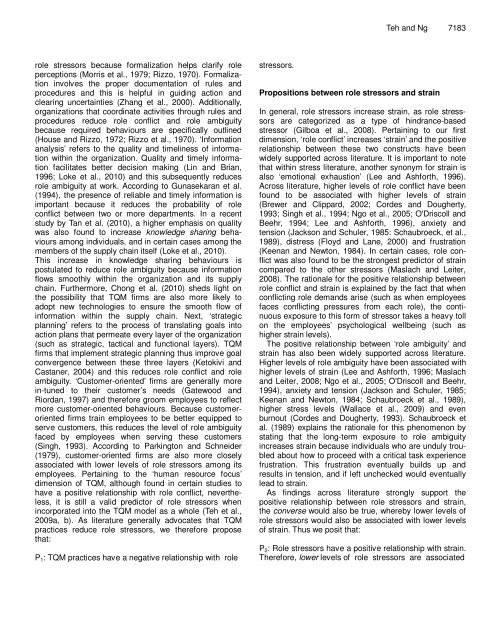Download Complete Issue (8760kb) - Academic Journals
Download Complete Issue (8760kb) - Academic Journals
Download Complete Issue (8760kb) - Academic Journals
You also want an ePaper? Increase the reach of your titles
YUMPU automatically turns print PDFs into web optimized ePapers that Google loves.
ole stressors because formalization helps clarify role<br />
perceptions (Morris et al., 1979; Rizzo, 1970). Formalization<br />
involves the proper documentation of rules and<br />
procedures and this is helpful in guiding action and<br />
clearing uncertainties (Zhang et al., 2000). Additionally,<br />
organizations that coordinate activities through rules and<br />
procedures reduce role conflict and role ambiguity<br />
because required behaviours are specifically outlined<br />
(House and Rizzo, 1972; Rizzo et al., 1970). ‘Information<br />
analysis’ refers to the quality and timeliness of information<br />
within the organization. Quality and timely information<br />
facilitates better decision making (Lin and Brian,<br />
1996; Loke et al., 2010) and this subsequently reduces<br />
role ambiguity at work. According to Gunasekaran et al.<br />
(1994), the presence of reliable and timely information is<br />
important because it reduces the probability of role<br />
conflict between two or more departments. In a recent<br />
study by Tan et al. (2010), a higher emphasis on quality<br />
was also found to increase knowledge sharing behaviours<br />
among individuals, and in certain cases among the<br />
members of the supply chain itself (Loke et al., 2010).<br />
This increase in knowledge sharing behaviours is<br />
postulated to reduce role ambiguity because information<br />
flows smoothly within the organization and its supply<br />
chain. Furthermore, Chong et al. (2010) sheds light on<br />
the possibility that TQM firms are also more likely to<br />
adopt new technologies to ensure the smooth flow of<br />
information within the supply chain. Next, ‘strategic<br />
planning’ refers to the process of translating goals into<br />
action plans that permeate every layer of the organization<br />
(such as strategic, tactical and functional layers). TQM<br />
firms that implement strategic planning thus improve goal<br />
convergence between these three layers (Ketokivi and<br />
Castaner, 2004) and this reduces role conflict and role<br />
ambiguity. ‘Customer-oriented’ firms are generally more<br />
in-tuned to their customer’s needs (Gatewood and<br />
Riordan, 1997) and therefore groom employees to reflect<br />
more customer-oriented behaviours. Because customeroriented<br />
firms train employees to be better equipped to<br />
serve customers, this reduces the level of role ambiguity<br />
faced by employees when serving these customers<br />
(Singh, 1993). According to Parkington and Schneider<br />
(1979), customer-oriented firms are also more closely<br />
associated with lower levels of role stressors among its<br />
employees. Pertaining to the ‘human resource focus’<br />
dimension of TQM, although found in certain studies to<br />
have a positive relationship with role conflict, nevertheless,<br />
it is still a valid predictor of role stressors when<br />
incorporated into the TQM model as a whole (Teh et al.,<br />
2009a, b). As literature generally advocates that TQM<br />
practices reduce role stressors, we therefore propose<br />
that:<br />
P1: TQM practices have a negative relationship with role<br />
stressors.<br />
Teh and Ng 7183<br />
Propositions between role stressors and strain<br />
In general, role stressors increase strain, as role stresssors<br />
are categorized as a type of hindrance-based<br />
stressor (Gilboa et al., 2008). Pertaining to our first<br />
dimension, ‘role conflict’ increases ‘strain’ and the positive<br />
relationship between these two constructs have been<br />
widely supported across literature. It is important to note<br />
that within stress literature, another synonym for strain is<br />
also ‘emotional exhaustion’ (Lee and Ashforth, 1996).<br />
Across literature, higher levels of role conflict have been<br />
found to be associated with higher levels of strain<br />
(Brewer and Clippard, 2002; Cordes and Dougherty,<br />
1993; Singh et al., 1994; Ngo et al., 2005; O'Driscoll and<br />
Beehr, 1994; Lee and Ashforth, 1996), anxiety and<br />
tension (Jackson and Schuler, 1985: Schaubroeck, et al.,<br />
1989), distress (Floyd and Lane, 2000) and frustration<br />
(Keenan and Newton, 1984). In certain cases, role conflict<br />
was also found to be the strongest predictor of strain<br />
compared to the other stressors (Maslach and Leiter,<br />
2008). The rationale for the positive relationship between<br />
role conflict and strain is explained by the fact that when<br />
conflicting role demands arise (such as when employees<br />
faces conflicting pressures from each role), the continuous<br />
exposure to this form of stressor takes a heavy toll<br />
on the employees’ psychological wellbeing (such as<br />
higher strain levels).<br />
The positive relationship between ‘role ambiguity’ and<br />
strain has also been widely supported across literature.<br />
Higher levels of role ambiguity have been associated with<br />
higher levels of strain (Lee and Ashforth, 1996; Maslach<br />
and Leiter, 2008; Ngo et al., 2005; O'Driscoll and Beehr,<br />
1994), anxiety and tension (Jackson and Schuler, 1985;<br />
Keenan and Newton, 1984; Schaubroeck et al., 1989),<br />
higher stress levels (Wallace et al., 2009) and even<br />
burnout (Cordes and Dougherty, 1993). Schaubroeck et<br />
al. (1989) explains the rationale for this phenomenon by<br />
stating that the long-term exposure to role ambiguity<br />
increases strain because individuals who are unduly troubled<br />
about how to proceed with a critical task experience<br />
frustration. This frustration eventually builds up and<br />
results in tension, and if left unchecked would eventually<br />
lead to strain.<br />
As findings across literature strongly support the<br />
positive relationship between role stressors and strain,<br />
the converse would also be true, whereby lower levels of<br />
role stressors would also be associated with lower levels<br />
of strain. Thus we posit that:<br />
P2: Role stressors have a positive relationship with strain.<br />
Therefore, lower levels of role stressors are associated

















